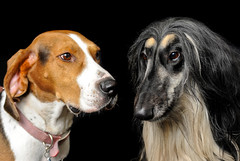The right diet can make all the difference in the world for your pet, but selecting the right pet food can be difficult. Advertisers would have us believe that those bags are full of nutritious, vitamin packed ingredients. A lot of the labeling terms are deceiving. Sometimes they don't adequately describe the material used. Other times they're just indecipherable terms. You might be shocked to know what some of those innocuous sounding terms are hiding.
Following are some interpretations of the ingredient terms you might see on the back of your pet food bag.
Meat by-products This includes all of the offal determined not fit for human consumption. In other words organs like the liver, kidneys, spleen, or intestines. It is permitted to use diseased organs in this category.
Poultry by-products This is the same thing, feet, heads organs all go into your pet's food.
Poultry by-product This is the same as above except that it is ground. Keep in mind that although "clean" meats are supposed to be used for these ingredients. Some contamination with feathers or fecal matter is considered unavoidable, so small amounts of these are permitted.
Animal Blood Animal blood is dried and considered an acceptable source of protein
Hydrolized Hair Really, the hair is cleaned and treated with heat to make it an acceptable ingredient in commercial pet food.
Other sources of protein often used are dehydrated food waste and dehydrated paunch. This list could go on, but I suspect you get the idea. Just keep in mind that if you find the term meat by-product on your pet food label your dog is really getting the waste materials collected during the slaughterhouse process. This stuff is deemed not fit for human consumption, yet the Association For American Feed Control Officials have no problem approving the stuff for Fido's food. Again this is about profit. If they can make money from the junk, the refuse then they absolutely will.
These ingredients make up a percentage of the dry weight, but the main ingredient is generally some kind of grain. Corn is used most of the time. Corn bran, corn flower, corn gluten: again these components are often the by-product of some other food industry process. Usually the milling process.
Wheat comes in a close second place on labels. So really, if your dog is eating a commercial brand pet food he is subsisting on a diet high in grains and low in protein. A dog's digestive system doesn't adequately utilize grains or carbohydrates in general. This just is not an ideal diet for an animal who is naturally a carnivore. It's entirely possible that your dog is malnourished if he has this kind of diet.
You'll be amazed by the improvements you see when your dog's diet is optimized. Expect a shinier, healthier coat. If your dog has a strong unpleasant "dog" odor you'll probably see improvement there as well. Muscle tone can improve, and many allergies and skin irritations are the result of poor nutrition.
Subscribe to:
Post Comments (Atom)

![Reblog this post [with Zemanta]](http://img.zemanta.com/reblog_c.png?x-id=b2d27e6e-9a28-4314-9ec1-62b9e0903e8f)
No comments:
Post a Comment